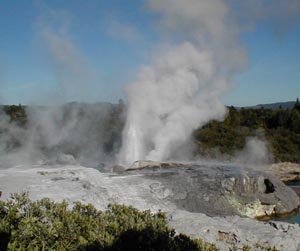
An erupting geyser in Rotorua New Zealand
Summer 2006 questions
Day 17 Thermodynamics
Temperature
Feel Temperature, have a group of people line up by hand temperature.
Temperature Illusion, adapt fingers to hot water or cold and then plunge them into room temperature water, one finger will feel the room temperature water as warm, the other as cool.
What is temperature, the changing definitions of temperature.
Negative Temperatures, use poker chips to investigate negative temperatures
Infrared Remote control, explore infrared radiation.
Geyser, how to build a geyser and how they work.

An erupting geyser in Rotorua New Zealand
Boyling water, use a syringe to boil water at room temperature.
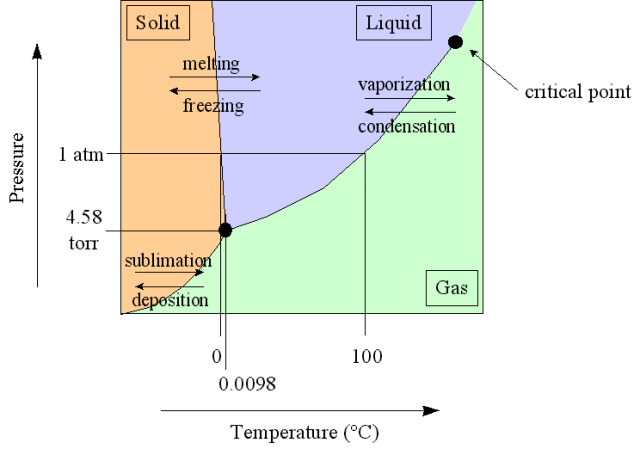
Phase diagram for water
Day 16 Electricity
Source of Neon Glow tubes Ne-2h
Mouser Electronics, search for neon tube or Ne-2h
http://www.mouser.com/search/ProductDetail.aspx?R=36NE005virtualkey50000000
Tsunami
Here is an article from Fantasy and Science Fiction about big waves and tsunamis.
Water waves, a web page about their shape and speed.
Water Wave speed, the equations for the speed of a water wave.
Putting oil on the water, it does prevent waves from starting.
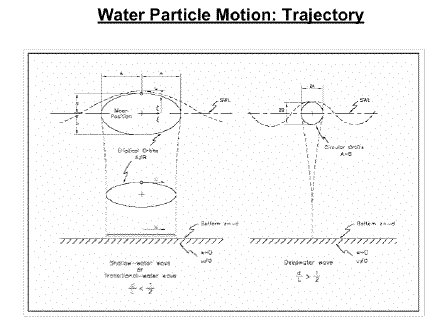
Notice the tsunami motion of water parcels that make up the wave moves the entire ocean, while the motion of regular wind driven waves on the left is only near the surface.
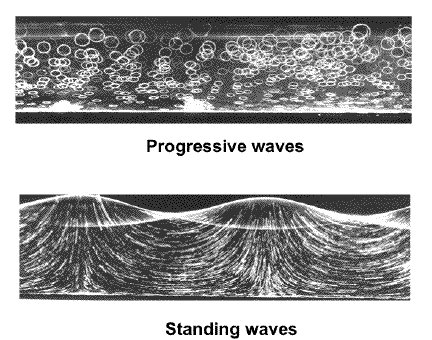
The above images show time lapse photos of neutral buoyancy particles suspended in water for a traveling wave top and a standing wave bottom.

The above image shows the instantaneous velocity of parcels of water in a traveling wave.
The above images are from this site: aqua.tvrl.lth.se/course/VVR040/lecture1.pdf
A good tsunami reference is: http://pubs.usgs.gov/circ/c1187/
Day 15 Electrostatics
You can buy heavy water for about $1 per 5 ml. Popular Science article on ice cubes made with heavy water sinking in normal water. Paul D also notes that ice cubes made with normal water will sink in high alcohol beverages, try 140 proof.
Neon glow tubes are available from Mouser Electronics for about $0.10 each.
Lightning, an article I wrote for Fantasy and Science Fiction on the occasion of the 300'th birthday of Ben Franklin.
Seeing Lightning, how to observe and photograph lightning,
Lightning Scientists, a short piece about scientists experiencing lightning.
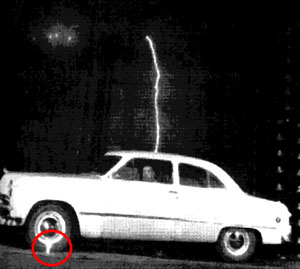
A car hit by artificial lightning, note the discharge from the hub
across the outside of the tire to the ground. Note also the person
inside the car.
Here is a tree with a lightning scar. Click the image to see an enlargement.
Lightning sound
If you've ever been close to a lightning bolt you may have heard a sharp "click" noise simultaneous with the bolt, followed a short time later by thunder. Scientists are still arguing over the source of that click. One scientist, Colin Keay of Australia, exposed ordinary objects such as aluminum foil and casuarina pine (common in Australia maybe) to very low frequency high amplitude,400,000 volts per meter, electric fields and recorded fairly loud clicking sounds from those objects. Keay claims a new scientific discovery he calls electrophonic sound production. However most physicists believe that the objects simply produce sparks, which are heard as clicks. Keay claims that his voltages are too low to produce sparks. A quick check of the literature however shows he is wrong, voltages as low as 300,000 volts per meter will produce sparks in humid air.
The real question was posed by Constance Holden of Science magazine who asked," If lightning strikes a tree in a forest when no one's around does it make an electrophonic sound?"
Here is an electron microscope image of the inside of polar bear fur. It is rough and hollow, good for insulation and for scattering white light, but not a fiber optic.
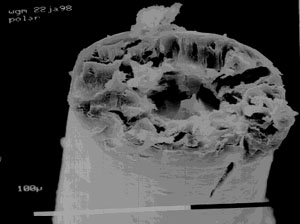
Day 14 Sharing
Coriolis
A wonderful image of hurricanes in the northern and southern hemispheres which spin in opposite directions due to the coriolis force is here. Hurricanes
Atomic Clock
NIST has just made an atomic clock based on Mercury. It is five times more accurate than the previous cesium atomic clock. It runs at optical frequencies rather than microwave frequencies.
Day 13 sound
Lift in airplane wings Bernoulli vs Newton
You'll often read that Bernoulli's law does not explain the lift of an airplane wing, but that Newton's law does (the wing deflects air down and the fraction force causes lift.) The truth is that both Bernoulli and Newton can be used to explain the lift on the wing. It is also true that aerodynamic engineers use neither explanation to calculate lift they use a third principle called circulation instead. Note that Bernoulli's law is just the law of conservation of energy and energy is conserved. The problems come when people misapply Bernoulli's law.
Example Drop a ball. Is the speed of the ball just before it hits the floor explained by Newton's law a = F/m = mg/m = g with v^2 = 2gh so v = (2gh)^0.5?
or is it explained by conservation of energy
1/2 mv^2 = mgh so that v = (2gh)^0.5
It is the same answer, both laws apply. Both are 100% correct explanations of the motion of the ball, and so are the laws of Bernoulli and Newton for lift of a wing.
Here is a photo of a wing in a wind tunnel that shows streamlines using smoke, pulses in the smoke show timing. Notice how the timing marks do not line up after passing over and under the wing. This means that the argument that the air flows faster over the wing because it has to meet up with the air that flows under the wing is wrong. It actually flows faster and gets there ahead of the air flowing under the wing.
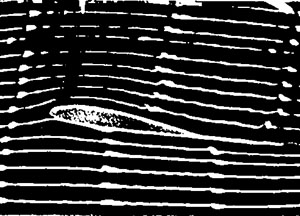
Keyboard duster
Some are compressed air, "Dust Off" is difluoroethane which is used by kids as an inhalant, it acts as an oxygen displacer like nitrous oxide.
How did vocal cords get their name when they are actually flaps?
Green Laser source
www.z-bolt.com, green lasers for $45, cheaper in quantity.
Rheoscopic Fluid
Flow visualization fluid, is available from Steve Spangler, stevespanglerscience.com.
Aluminum rod source
Thanks to Jack: Fendell
The place to but the tempered aluminum is TCI Aluminum North 2353 Davis Ave, Hayward (510) 786-3750.
Look in the yellow pages under metals, call several places for pricing, check if they have a minimum order.
Day 12 Sound
Bernoulli's Law
The correct statement of Bernoulli's law.
When a fluid speeds up its pressure decreases. When it slows down the pressure decreases.
( the incorrect version is high speed air has low pressure.)
This statement requires that you point to two places to compare the speed and pressure at one place to the speed and pressure at the other. The same parcel of fluid must flow from one place to the other (usually along a streamline.)
So a high speed wind blowing over flat ground exerts atmospheric pressure on the ground.
When it flows over a building it must speed up and so the pressure is reduced and the combination of the high pressure inside the building with the low pressure above the building lifts off the roof.
Whirlies a lecture and science notes given at the AAAS meting in 2001.
There is a sound channel (SOFAR) in the Pacific Ocean 600 to 1200 m deep in which sound waves become trapped. The speed of sound inside the channel is less than the speed of sound in the water above and below the channel. The speed of sound is determined by the density and composition of sea water. Increasing the density of sea water by changing its temperature or salinity will decrease the speed of sound.
Heating BB's by throwing them
If you take a cloth bag of BB's and measure its temperature.
And then throw the cloth bag 10 m in the air a few times allowing it to collide with the floor after each throw the temperature of the BB's in the bag will increase noticeably, T.
Gravitational potential energy = mgh = internal energy increase mcT
where c is the specific heat of steel, perhaps 0.3 cal/°C gram. or 1 Joule/°Cg or 10^3 J/°Ckg
Notice how the mass cancels and we get T = gh/c = 10 *10/1000 = 0.1 °C per throw.
Day 11 Sound
The Sound Level meter, also known as a decibel meter, can be purchased at Radio Shack. For about $35.
Introduction to the decibel meter
The refraction tank has at least 2 cm of Karo syrup (with a pinch of powdered milk stirred in) and a 2cm or thicker layer of water gently poured over the karo syrup, one drop of milk or a pinch of powdered milk is added to the water. Allow the layers to stand for a day or two, the water will diffuse into the sugar syrup. Shine a laser into the tank and notice how the laser bends . You can shine the laser upward into one side of the tank and it will bend down through the layer in which the water and sugar mix. The speed of light in water is greater than the speed of light in the syrup. This causes refraction of the light wav.
The sound made by a resonator depends not only on its resonant frequencies, but also on the source of sound driving the resonator. Thus a whirly has several resonant frequencies, by changing the speed of air flow through the whirly you can change the spectrum of sound driving the whirly and therefore change the sound that it sings.
Tightening a guitar string listening to the pitch increase
If the string of a musical instrument is vibrating with a range of resonant frequencies and then you change the tension on that string (which you can do for a steel string without changing its length or density by much at all.) You will change its resonant frequencies. If there already were vibrations that included these new resonant frequencies then they will become amplified by the new resonance. Also the act of stretching the string may create sounds which get amplified by the new resonances. Thus when you tighten the string you may hear a musical tone rising in pitch.
Day 10 Sound
Listening to Gravity, how your inner ear detects gravity, acceleration and rotational acceleration.
Iron Superoxide
The Viking Lander found Iron Superoxide. A superoxide contains oxygen in the -1/2 oxidation state, for example K02 is potassium superoxide. Recently iron superoxides were found in the Atacama desert where it hasn't rained for a hundred years.
Day 9 Questions
Polarizing Material
See http://en.wikipedia.org/wiki/Polaroid
The original material, patented in 1929 (U.S. Patent 1918848) and further developed in 1932 by Edwin H. Land and David Horvitz, consists of many microscopic crystals of iodoquinine sulfate (herapathite) embedded in a transparent nitrocellulose polymer film. The needle-like crystals are aligned during manufacture of the film by stretching or by applying electric or magnetic fields. With the crystals aligned, the sheet is dichroic: it tends to absorb light which is polarized perpendicularly to the direction of the crystal alignment, but transmits light which is polarized parallel to it. This allows the material to be used as a light polariser.
This material, known as J-sheet, was later replaced by the improved H-sheet Polaroid, invented in 1938 by Land. H-sheet is a polyvinyl alcohol (PVA) polymer impregnated with iodine. During manufacture, the PVA polymer chains are stretched such that they form an array of aligned, linear molecules in the material. The iodine dopant attaches to the PVA molecules and makes them conducting along the length of the chains. Light polarized parallel to the chains is absorbed, and light polarized perpendicular to the chains is transmitted.
Ways to light an LED with an electromagnet.
- Use the coil of an electric toothbrush recharger to induce a current in a coil of wire.
- (In Square Wheels), put doughnut magnets between two film cans, and wrap this in clear overhead transparency plastic. Wrap that in magnet wire. Shaking the magnets will light an LED. (The Exploratorium server was down when I tried to add this link)
The best source of information on aerodynamics:
NASA beginner's guide to aeronautics.
http://www.grc.nasa.gov/WWW/K-12/airplane/bga.html
Terminal Velocity
Note coffee filters work well for Lee's terminal velocity activity.
The air resistance force, Ff, for a falling coffee filter is proportional to the square of the velocity, v.
Ff = kv^2 set this equal to the force of gravity, with m as the mass of the filter and g as the acceleration of gravity to get the terminal velocity.
Ff = kv^2 = mg,
solve for v as a function of m, mass v = (mg/k)^0.5
So the terminal velocity is proportional to the square root of the mass of the falling object (as long as the falling object has the same cross sectional area which determines the constant k.
Day 8 questions
Second Life, is a virtual 3-D world suitable for science teaching.
http://secondlife.com, check it out with a free account.
The name of my museum is the Splo.
To get a set of landmarks to the 'Splo science museum, the Louvre, and the ISM, the International Spaceflight Museum send an IM inside the game to Patio Plasma.
Chinese Compass
You can get Chinese compasses online. Look for "south Chinese compass" on ebay or search for "south Chinese compass spoon purchase" on google.
http://www.dragon-gate.com/shopping/product/productDetail.asp?cid=11&id=1472
The compass seen for sale on this site is $58. It is the same size as the one I showed in class. I believe that price is a bit high.
Imaging a light wave
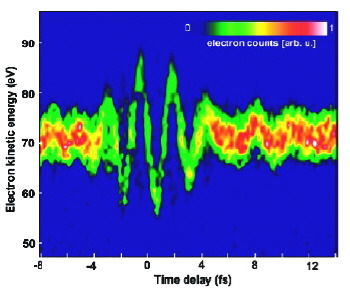
The units of time on the horizontal axis are fs, femto seconds, 10^-15 s.
This image shows two strong positive peaks from a less than 10 fs long pulse of light.
The image was obtained by collecting electrons accelerated by the electric field of the light wave.
The magnetic field reversals of the earth
Here is a site on the proposed mechanism for the reversal of the earth's magnetic field.
magnetic field reversal http://www.psc.edu/science/Glatzmaier/glatzmaier.html
It has movies of a theoretical model of what happens to the magnetic field of the earth during a magnetic reversal.
The electromagnetic field produced by the rotating convection liquid iron of the outer core spinning in its own magnetic field (magnetohydrodynamics) creates eddy current that creep into the solid iron of the inner core. These eddy currents cause a slow decrease in the total magnetic field. and provide an opposing magnetic field that may trigger a reversal of the total magnetic field of the earth.
Day 7 Magnetism
At Project RAFT
Magnetic Navigation, an essay by Paul Doherty about the magnetic field of the earth and how it can be used as an aid to navigation.
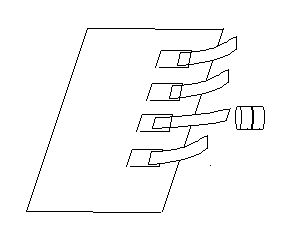
Magnetic tape, Use magnetic cassette tape to show how magnetic materials can be used to record digital information.
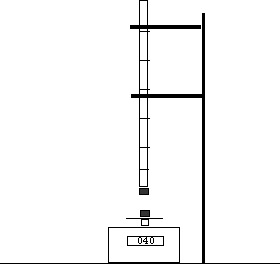
Magnetic force law. The force betwen two magnetic monopoles falls off as 1/r^2 , it is an inverse square force, however, the force between two magnets is the force between two dipoles (a north and a sout pole together) and falls off as 1/r^4. This can be measured using a digital scale.
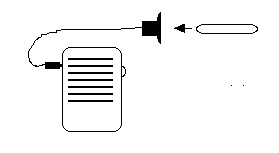
Audible Magnetic domains, A coil of wire will allow you to hear the motion of magnetic domain walls as a piece of iron becomes magnetized.
Push a grape, strong magnets can be used to push a grape. The sugar water of the grape is diamagnetic.
Magnetism
of the Planets, a photo essay about the
magnetic fields of planets.
References,
about the magnetism of planets.
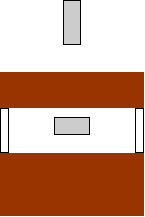
Floating in copper, use thick slabs of copper to slow down the motion of strong magnets due to eddy currents so that the magnets can be flownby a human.
Day 6
Monday 7/3
Water Wave Diffraction
What is the right beach (and the right time?) to see wave diffraction.

Notice the circular wave coming out of the rectangular slit in the
middle of the island off the coast of Big Sur. To see this view go
there in the late winter or spring in the morning and at high
tide.
Lasers
Light amplification by stimulated emission of radiation.
Some pointer lasers are made of GaAsP -- solid state -- let out 70% of light instead of 2% in regular lasers. Light makes 50 passes in cavity in regular laser, only 2 passes in pointer laser.
Lasers clssification..
Class 1 laser power asured in microwatts. - can give to students
Pointer lasers are usually Class 2, so you shouldn't give to students. Those are 1 mW or less in power. Have never caused blindness.
Several pointers are Class 3. above 1 milliwatt. At 10 mW may cause blindness.
Class 4 will burn flesh and cause blindness
Class 5 will burn through metal (weapons grade)
(Well actually there are no moons of earth, they
all orbit the sun in a 1 year period and interect with the earth
gravitationally, so they are co-orbital bodies of earth)
After the Moon the next largest co-orbital asteroid is Cruithne 5 km in diameter, pronounced Crooeenya. after an ancient Pict tribe in Britain, and the third is 2002 AA 29 100 meters in diameter.
Light sources
Instead of mini mag light, you can cut out single lights from Christmas lights and wire them to a 1.5 V battery
Speed of Light
Galileo tried to measure the speed of light but failed. He did great science, he did an experiment that showed him he had failed.
Roemer measured the speed of light using the eclipses of Io to within 10% of the current value. http://www.sasked.gov.sk.ca/docs/physics/u3a22phy.html
Day 5
The Speed of light in a vacuum is about one foot per nanosecond or 1/3 meter per nanosecond.
Atomic orbitals
Have students make models of the atomic orbitals using clay or more modern substances
Crayola - sells model magic - can make electron orbital shapes which solidify into form
Atomic orbitals have the basic shapes of the Spherical Legendre polynomials
Planetary Shapes an essay by Paul Doherty that mentions the shapes of atomic orbitals.
A great inexpensive program to draw atomic orbitals is Atom in a box. (Available only for Macs.)
5 Flavors
There is a new flavor added to the usual, sweet, sour, salty, bitter, it is:
Umami the flavor of Monosodiumglutamate.
The three fundamental forces of nature
This site provides the latest understandable information of the particles and forces that make up the world.
Fundamental Chart of Particles and Interactions.
and here is the online version of the chart
It is an excellent site created by a physics researcher/science teacher collaboration.
References: Seeing the Light, Deiter Brill et,al. the best book on color vision ever written.
Snack for exhibit where electric current changes the pH.
Needed from Charlie Carlsen
GPS
GPS receivers would have an error of 7 miles/day if they were not corrected for general relativity
An article from Fantasy and Science Fiction by Paul Doherty and Pat Murphy.
Colored Filters
Source for best colored filters for Red Green and Blue. (These are the best but they are not perfect the blue in particular is not great.)
Colored Filters
We purchase our colored filters from Holtz-Muller theater supply in San Francisco, #415-826-8383
They are $6.50 per sheet, 20 x 24 inches
TI uses Roscolux Medium Red #27
Roscolux #80 Primary Blue, and
Lee Filters #139 Primary Green
Demos for the Friday presentations.
Falling Faster than G , drop a slinky and observe how the top, bottom and center of mass fall compared to a ball.
Spin a Kooshball, and demonstrate the equatorial bulge of a rotating planet.
Day 4
Resources
A great source for physics teaching materials is:
Educational Innovations, Cos Cob CT
A source for diffraction gratings is Learning Technologies, Cambridge MA
For more on color see my out-of-print book Colors of Nature.
Melanin in the lens and UV vision in humans.
I need to find my source for the story of the British night bombers being seen by German pilots because of the ultraviolet glow of the exhaust gasses.
Squirming Palm Exhibit Question
Why does the "Squirming Palm" exhibit dot pattern appear to have radial bands when it is spun?
Observations:
The number of radial bands increases when the wheel is spun more quickly.
At slow rotation speeds the center of the pattern, where the bands cross is not the center of the rotating disk, but is displaced from the center of the disk toward the point you are looking at. At higher speeds the center of the pattern is at the center of the disk.
Color Anomaly
The red and green cone are encoded in genes on the X chromosome. Men, XY, only have one X chromosome, women, XX, have two.
In a sample of 236 men there were found to be 85 variants to the chemical that detects red light. There was essentially only one variant of the green cone. There are so many variants of the X that women often have 2 different reds and so have four cones.
Newton Names the colors:
http://www1.umn.edu/ships/updates/newton1.htm
Newton's color-mixing circle had transformed the linear spectrum into a circle. Newton may have seen colors as cyclical. He certainly saw them as musical, much as Aristotle had. At first, Newton split his spectrum into five principal colors. But the number did not fit his conception that colors, like notes of music, expressed harmonies. A spectrum of colors, like a musical scale, he imagined, must have seven steps to make a full octave. (Note, here, the converse use of the color term 'chromatic' applied to musical scales that include all their accidentals, or half-steps.) To arrive at the requisite seven "notes," then, Newton inserted orange and indigo into his initial scheme, each addition representing a narrow "half-step" appropriately spaced in the spectral "scale." The roygbiv designation so familiar today thus not only reflects an arbitrary division of the spectrum, but also one shaped by a musical notion of octaves and the diatonic scale.
Size Distance
An image showing size/distance from Sebastian

Slow Light
Recently Lena Hau of the Rowland Institute managed to slow light down to 17 m/s this is slightly faster than Paul's maximum speed on a bicycle. here is an article I wrote about how she did it.
Day 3 Questions
The human eye is equal to what megapixel camera.
Well, there are 100 million rods and cones in the human eye so if they all operated independently the eye would be a 100 megapixel camera. But, in many regions of the retina the rods and cones are wired together so large bundles of light sensors produce nerve impulses together.
In the fovea the cones are closely packed together with 1 micrometer spacing between centers. However the spacing increases with distance from the fovea. So the answer is less than 100 megapixels.
The fovea extends over only a couple of square degrees. However almost all we actually see is from the fovea. So the resolution of the eye is like that of a 100 megapixel camera.
Where does the word pupil come from.
When you look into the black disk of near the center of a human eye you can see the small reflected inverted image of nearby people. Small people are pupils so that's how the pupil of the eye got its name.
Where did the word humor, as in aqueous humor come from?
In ancient medicine there were 4 humors in the body, blood, phlegm,choler and black bile. The health and disposition of people was thought to be influenced by the relative amounts of these biles within that person.
What is epilepsy?
Spontaneous firings of neurons in the brain.
Why does an evacuated flask with water in it sound strange and emit light when shaken?
In an Erlenmeyer flask partially filled with water if you boil the water, cap the flask and shake it the water sounds like glass and emits light, why? When the water boiled it filled the space above the water with water vapor driving out the air. When capped and cooled the water vapor condenser leaving a good vacuum in the space above the water. Without air in the space to slow it the water collides rapidly with the walls of the container making a click or glass like sound. The light may be coming from sonoluminescence, intense sound (or shaking) can produce bubbles in water. These bubbles collapse with accelerations of thousands of g's resulting in a small intense collision in the center of the bubble where a few molecules are heated to extremely high temperatures causing the emission of light.
Melanin in the eye, the skin and hair
Melanin is a molecule that absorbs light. It absorbs all visible light and more. It absorbs more blue light than red. So a little melanin removes blue from white leaving yellow (blonde hair) more melanin removes much blue and some green leaving brown (aka dark orange) and even more removes all visible light leaving black hair. Melanin absorbs ultraviolet light even more than blue and so the body produces melanin to protect human skin against UV light. Melanin in the skin darkens the skin producing a tan. Melanin also colors the iris in a human eye.
Find out about melanin in the book Molecules by P.W. Atkins
The Periodic Table
Find out about the periodic table in the book The Periodic Kingdom by P.W. Atkins
What is mineral oil?
It is a petroleum distillate.
What causes refraction, Wikipedia has a great answer under refraction.
A light wave travels at the speed of light in a vacuum. When it encounters an atom the light wave shakes the electron cloud of the atom. Some of the energy of the light wave goes into the atom. The oscillating electron cloud then emits light at the same frequency as the original light. But, there is a slight delay in the emitted light. This emitted light then strikes other atoms excites their electron clouds into oscillation and then is emitted again with a delay. A delay at every atom produces a slowing of the speed of light in a material. The actual speed depends on the delay at each atom and on the number of atoms. The index of refraction is the ratio of the speed of light in a vacuum to the speed of light in a material. By the way each atom must delay the light by a small fraction of the period, perhaps 1/3 of the period. The period of yellow light at 600nm wavelength is 2 x 10^-15 s, so each atom delays the light by 0.7 x 10^-15 s or 7 x 10^-16 s. A very short delay.
Optical density and physical density
This is why optical density is not the same as physical density. For a given set of atoms say nitrogen gas the index of refraction, the optical density, is proportional to the physical density. In another set of atoms say oxygen the same is true, but the constant of proportionality is different for each material. So two materials of different physical density can have the same optical density for example Pyrex glass and mineral oil can have the same optical density but glass is denser than mineral oil.
Day 2 glass flow
Glass doesn't flow
Paul's page on scientific myths
At room temperature for a 1 m high window 1 cm thick it would take 10^10 years to thicken by 10 angstroms (1 nm). 10^10 years, or 10 billion years, is the age of the Universe. (actually the age of the Universe is 13.7 +- 0.2 billion years.)
In the last few years the Corning Museum has revised its estimate for the viscosity of glass, it is now given the value of 10^20 poise at room temperature. Lead has a viscosity of 10^11 poise. So glass is a billion times less of a liquid than lead.
ASTM definition of a fluid
The Engineering definition for solid liquid or gas.
The ASTM (American Society for Testing and Materials) has a standard for determining whether something is a liquid. ASTM (1996) "D4359-90: Standard Test Method for Determining Whether a Material Is a Liquid or a Solid."
Here is their method: The material under test is held at 100deg.F (38deg.C) in a tightly closed can. The lid is removed and the can inverted. The flow of the material from the can is observed to determine whether it is a solid or a liquid.
They specify that the material in a 1 Liter container must flow over 2 inches in three minutes to be considered a liquid.
Under this test glass is definitely a solid.
Laser Source
A good source for pointer lasers is Z-bolt laser supply.
I now buy the slightly more expensive pointer lasers that use AAA batteries.
Since it is difficult and expensive to find the button cells for the smaller laser pointers.
I did manage to find and buy the laser button cell batteries on e-bay.
Source of Scientist biographies
Asimov's Bibliographic Encyclopedia of Science and Technology
Comparing Yellows
by Gorazd Planinsic
Using LEDs and ping pong balls.
The Physics Teacher, March 2004
http://scitation.aip.org/journals/doc/PHTEAH-ft/vol_42/iss_3/138_1.html
Gorazd also created the single water drop laser projection microscope.
Paul's Quotes
"What do you see?"
"Without a human eye and brain there is no color!"
Benjamin Franklin "About light, I am in the dark."
The number of colors in the spectrum
ROYGBIV
Isaac Newton named the colors of the spectrum,
He named 7 colors so there would be the same number of colors as there are musical notes. (At first he named 5 colors, but added two more to bring the total to 7.)
He also realized the importance of understanding perception, how the eye and brain work, while observing nature and scientific experiments. To do this he did experiments in which he inserted a knitting needle into his eye socket beside his eye ball and moved his eyeball observing the resulting changes in his perception.
Day 1 frequency of flashing light that triggers epilepsy
5 to 30 Hz
|
Scientific Explorations with Paul Doherty |
|
27 June 2006 |